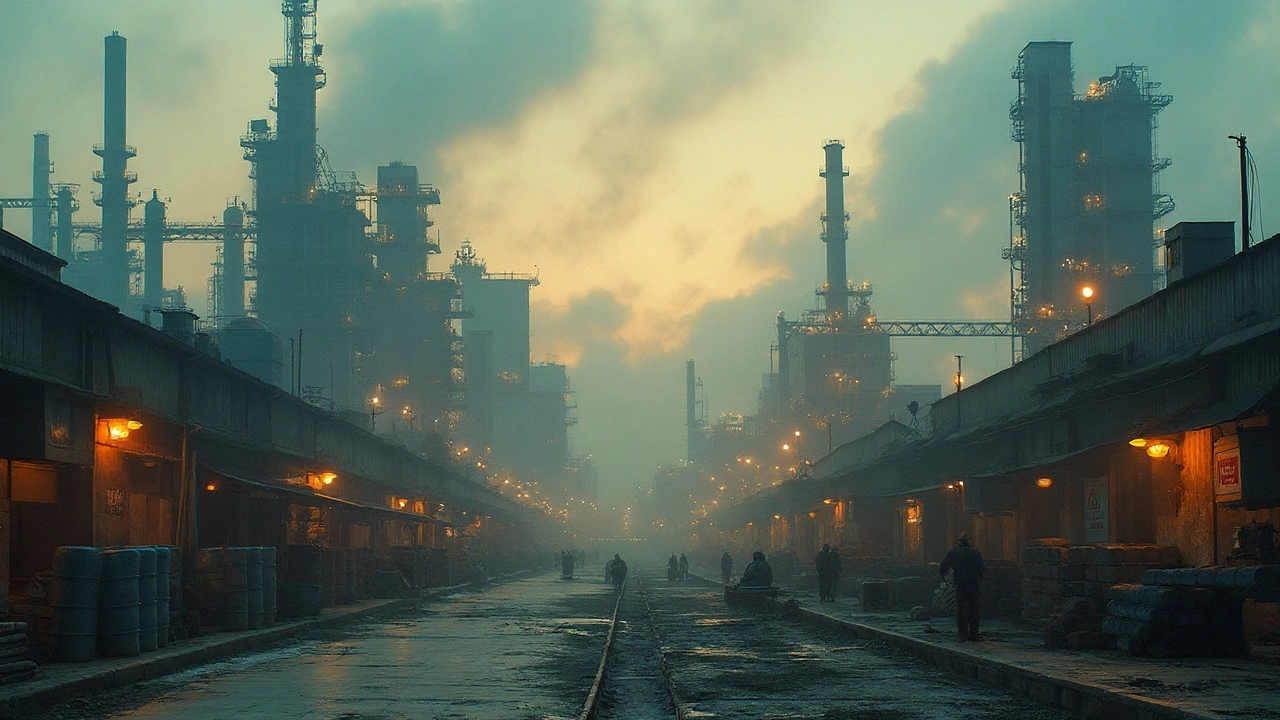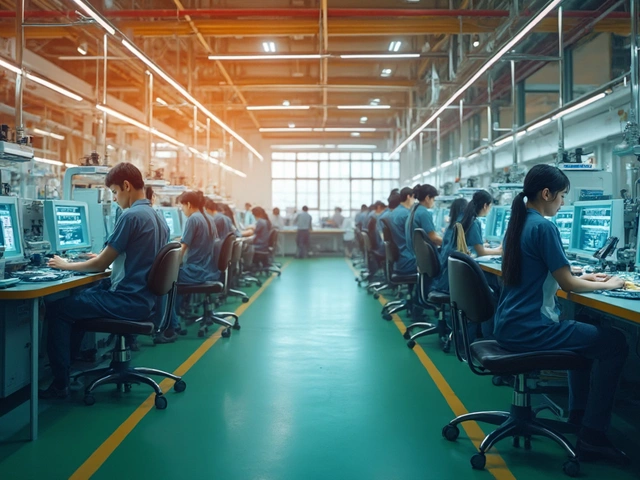If you’re running a factory in India right now, or even thinking about starting one, chances are, the words 'chemical shortage' hit a nerve. Maybe your supplier’s been ghosting you about caustic soda. Or your costs for acetic acid have shot up so much, you wonder if someone’s adding gold dust to every drum. This year, the shortage story isn’t just a blip—it’s turning manufacturers’ hair gray from Ahmedabad to Kolkata. So, what’s driving this weird chemical drought, why are certain names like soda ash and hydrogen peroxide suddenly getting unicorn status, and what’s the ripple effect? Let’s sort the chaos, armed with concrete facts your business can actually use.
The Current Chemical Shortage: What’s Hard to Find and Why?
Walk into any chemical trading market in India right now—Mumbai’s Chembur or Delhi’s Sadar Bazar—and you hear the same complaints: prices are up, deliveries are late, and some products are just plain missing. Top on the missing-in-action list are caustic soda, soda ash, acetic acid, hydrogen peroxide, and a couple of key solvents like ethyl acetate. Paint and paper manufacturers feel the pinch because hydrogen peroxide and caustic soda are crucial for bleaching and cleaning processes. Textile players? They suffer each time soda ash vanishes because it’s essential for dyeing and washing fabrics. And don’t get me started on pharmaceutical manufacturers who rely on a steady stream of solvents and basic chemicals to keep operations alive.
Why this sudden scarcity? It’s a cocktail of international factors. China—the world’s chemical juggernaut—faced factory closures and port slowdowns throughout early 2025 thanks to stricter environmental norms and intermittent power shortages. Indian chemical manufacturers who depend on major imports from China, especially for base chemicals and intermediates, were left scrambling. At the same time, erratic monsoons in India (again, thanks to El Niño) reduced water levels, especially in Gujarat’s manufacturing belt. Now, caustic soda and soda ash makers can’t operate at full capacity. On top of all that, global shipping cost spikes in the Red Sea, thanks to attacks on commercial ships, make importing from Europe and the Middle East far less predictable or affordable.
To sum it up, the shortage isn’t one villain—it’s a perfect storm. Policies, weather, and geopolitics have all muscled in. 2025 isn’t the first tough year for chemical buyers, but the scale this time makes it different. In May 2025, the average price of high-purity caustic soda hit Rs. 63 per kg—nearly 80% up from the previous year—and that’s if you could find a supplier willing to commit to a delivery date. Hydrogen peroxide posted a similar jump, making even large buyers like Hindustan Unilever reconsider their inventory calendars. Smaller players either delay production or pay above-market rates. If you want goods fast, you pay a hefty 'premium', often in cash.
What do numbers actually look like? Here’s a quick table based on industry data from April to July 2025:
| Chemical | 2024 Avg Price (Rs./kg) | 2025 Avg Price (Rs./kg) | 2025 Domestic Availability |
|---|---|---|---|
| Caustic Soda | 35 | 63 | Severely limited |
| Soda Ash | 28 | 45 | Low stock |
| Hydrogen Peroxide | 32 | 54 | Highly restricted |
| Acetic Acid | 70 | 124 | Sporadic |
| Ethyl Acetate | 62 | 104 | Very limited |
So if you, say, run a detergent plant in Gujarat, or a textile dyeing unit in Tamil Nadu, these numbers translate into real headaches. Delayed orders, unhappy customers, mounting debts—sound familiar? You’re not alone. India’s chemical trade groups estimate roughly Rs. 7,000 crore in lost production output in just Q2 of 2025. There’s been a massive uptick in 'grey market' deals—uncleared, untaxed imports sold through under-the-table channels. And in a country where safety and compliance already pass through loopholes, desperate buyers often take whatever turns up, running real risks in both quality and legal exposure.
Industry Breakdown: Sectors and Companies Getting Hit Hardest
If you imagine 'chemical shortage' as something that hits only the manufacturing giants, think again. India’s chemical value chain touches way more businesses than you’d expect—from soap and glass makers, to water treatment plants and even agrochemical blenders. Textiles, for example, eat up almost 20% of India’s soda ash and caustic soda output. If you’re tracking the color and comfort of the shirts you buy, chemical supply squeezes are backstory you’d never spot on a price tag. The impact stretches well beyond factories to affect the farmer buying fertilizer, the baker needing baking soda, or even the local municipal body tasked with purifying water.
Let’s get granular. Among the largest companies, Grasim Industries (a top producer of caustic soda) scaled down output by nearly 20% in June 2025, blaming water scarcity and raw material shortages. Gujarat Alkalies and Chemicals Ltd reported similar slowdowns despite desperate attempts to stabilize supply by buying intermediates from non-traditional sources like Vietnam and Malaysia—even then, lead times ballooned from the usual two weeks to as long as two months. Asian Paints, a major downstream killer absorber of acetic acid and ethyl acetate, flagged record input costs and unpredictable supply schedules in their Q1 financial briefing. They’re not alone—pharma majors like Sun Pharma and Dr. Reddy’s have faced parallel struggles in sourcing basic chemicals, putting pressure on medicine output and pricing.
This pain clearly trickles down. Medium and small enterprises (MSMEs) actually get hit harder. Unlike big businesses, they don’t have deep pockets to stockpile materials, nor the size to strong-arm suppliers for priority delivery. There’s a knock-on effect—laborers get stood down due to idle machinery, deliveries fall behind, and eventually, retail prices of finished goods move up. A small soap manufacturer in Kanpur admitted to shutting shop for two weeks in June because, “Just couldn’t get caustic soda—even after offering advance payment.”
Down the consumption line, consumers see higher retail prices. Washing powder and glass windows now cost up to 12-15% more than last year. Government-run water plants in Pune and Lucknow reduced operating hours. India’s largest bleach manufacturer in Hyderabad introduced quotas for their regular buyers, asking them to sign up two weeks in advance and stick to their scheduled pickups. Expect more rationing, not less, if the bottlenecks continue into the festive season later this year.

Supply Chain Solutions and Workarounds: How Indian Industry Is Coping
With the shortage set to continue at least until late 2025, there’s a wild scramble for alternative sources and creative fixes. Some factories substitute raw materials—though that isn’t always possible or safe. Textile dyers in Surat, desperate for soda ash, turned to locally sourced sodium bicarbonate (baking soda) for limited runs, but the results varied in quality, and input costs often just migrated elsewhere. In water treatment, where caustic soda is king, several urban plants started importing lower-concentration solutions—less efficient, more volume-heavy, but at least they keep things moving.
Importers and large buyers organize 'pool buying'—several companies team up, put in joint orders from Southeast Asia or Turkey, and split shipments. This helps them secure volume discounts but requires honest middlemen, which isn’t always a given. A chemical importer in Mumbai described emailing his Turkish supplier at 2am, negotiating entire shipment lots in WhatsApp voice notes because of time differences and urgency. If you’re a buyer on the sidelines, watch for sudden offers from shell trading companies; these 'middlemen' often pop up and then disappear after payment, a growing headache noted by multiple trade associations.
- Make friends with verified suppliers, not just the ones offering the lowest prices. Counterfeit or contaminated chemicals are a real risk, and regulatory authorities have caught over 60 bootleg chemical consignments in major ports since March 2025.
- If possible, negotiate longer-term contracts, even if it means paying a pre-agreed premium up front. The uncertainty is so wild, any supplier will favor consistent buyers.
- Diversify sources, even if it seems less cost-effective in the short run. Having one reliable back-up can save your operations in a crunch. Some Indian paint companies started importing chemicals from North Africa, absorbing high freight but beating local outages.
- Re-think production processes to minimize chemical consumption. Shift to batch processing from continuous runs, as this lets you pause production if you spot a bottleneck incoming.
- Work with your local trade group. These associations often get early hints about which consignments are delayed, where customs checks have snarled things, or if a rival’s consignment got stuck at the port. Information in this crunch is currency.
Software adoption is up. From inventory tracking to AI-driven forecasting, companies don’t trust old spreadsheets to predict wild spikes. In fact, a recent industry poll by the Indian Chemical Council found that 46% of manufacturers plan to invest in digital supply chain tools this year, up from only 19% in 2023. Those with real-time dashboards spot shortages faster, communicate with partners more efficiently, and see fewer last-minute surprises.
The Road Ahead: Outlook and Tips for the Next 12 Months
No sugarcoating here—the chemical supply challenge isn’t vanishing next month. Climate issues in India persist, and China’s own regulatory bottlenecks show little sign of easing quickly. But crisis breeds opportunity, if you’re nimble. There’s an uptick in domestic investment: Reliance Industries and Aditya Birla have both signaled plans for new soda ash and caustic soda units in Gujarat, aiming to go live by late 2026. The Indian government, alarmed by the country’s heavy dependency on China, rolled out fresh incentives in July 2025 for greenfield chemical projects under the Production Linked Incentive (PLI) scheme—the first time these incentives specifically targeted specialty as well as bulk chemicals, not just pharma or electronics.
For businesses, a few real-world tips can help ride out the storm:
- Keep a close eye on port activity reports—delays at Nhava Sheva and Chennai have become routine, but sometimes, lesser-used ports like Mundra offer faster clearance.
- Consider direct imports with freight forwarding partners who specialize in chemicals. They often know how to dodge common bottlenecks that stall large shippers.
- Don’t sleep on government updates. The Directorate General of Foreign Trade (DGFT) issues regular alerts on changing trade restrictions and anti-dumping duties. Last April, a sudden notification on anti-dumping duty for Chinese hydrogen peroxide sent buyers into panic mode—those who subscribed caught it first.
- Review insurance for your chemical stocks. With value volatility, many under-insure, and claims become a nightmare when a fire or spill coincides with peak prices.
- Invest in staff training, especially for inventory and quality control teams. Shortcuts are tempting, but one bad batch can wreck weeks of production and future business.
Many emerging entrepreneurs, seeing the cost crunch and unpredictability, are shifting to less chemical-intensive manufacturing, or innovating with recycled inputs. A recycled-glass startup in Pune now sources their own soda ash from within the waste glass melting process, cutting out external purchasing almost entirely.
So if you’re staring down a chemical shortfall—maybe cursing market reports or nervously checking prices on Telegram groups—you’re sharing pain with half of industrial India. But knowledge, and a proactive approach, can keep your margins alive. The right supplier, the right data, and a big dose of adaptability—that’s how you outmaneuver a supply crisis, keep your line running, and maybe even turn crisis into opportunity.





